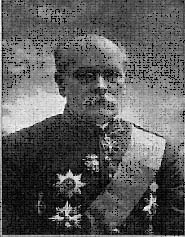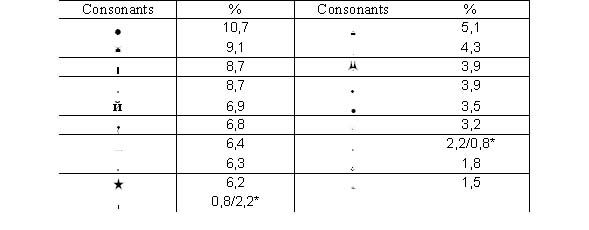Difference between revisions of "Anton Semënovič Budilovič"
WikiLingua (talk | contribs) |
WikiLingua (talk | contribs) m |
||
| (6 intermediate revisions by 3 users not shown) | |||
| Line 6: | Line 6: | ||
| − | [[Image:Vowels.jpg | + | [[Image:Vowels.jpg]] |
| + | |||
Likewise, the percentual frequencies of consonants can be taken from Table 2: (ibd., 97): | Likewise, the percentual frequencies of consonants can be taken from Table 2: (ibd., 97): | ||
| − | [[Image:Consonants.jpg | + | [[Image:Consonants.jpg]] |
| Line 26: | Line 27: | ||
== References == | == References == | ||
| − | + | *Budilovič, A.S.. 1875a. Něskol'ko dannych i soobraženii iz oblasti obščestvennoj i ėkono¬mičeskoj statistiki Čechii, Moravii i Avstrijskoj Silezii za poslědnie gody. In: ''Slavjanskij sbornik'', I. | |
| − | + | *Budilovič,A.S.. 1875b. ''Statističeskija tablicy raspredělenija slavjan: a) po gosudarstvam i narodnostjam i b) po věroispovědanijam, azbukam i literaturnym jazykam (narěčijam), s ob jasnitel'noju zapiskoju''. Sankt Peterburg. | |
| − | + | *Budilovič, A.S.. 1883. ''Načertanie cerkovnoslavjanskoj grammatiki, priměnitel’no k obščej teorii russkago i drugich rodstvennych jazykov''. Varšava. | |
| − | + | *Dobrodomov, I.G.. 1996. Anton Semenovič Budilovič. In: ''Russkij jazyk v škole 2'', 102-105. | |
| − | + | *Förstemann, E.. 1852. Numerische Lautverhältnisse im Griechischen, Lateinischen und Deutschen. In: ''Germanische Zeitschrift für Vergleichende Sprachforschung auf dem Gebiete des Deutschen, Griechischen und Lateinischen 1''. 163-179. | |
| − | + | *Förstemann, E.. 1846. Über die nummerischen Lautverhältnisse im Deutschen. In: ''Germania'', (Hrsg. von der Berlinischen Gesellschaft für deutsche Sprache und Altertumskunde), Bd. 7.. 83-90. | |
| − | + | *Grzybek, P. & Kelih, E.. 2003. Graphemhäufigkeiten (am Beispiel des Russischen). Teil 1: Methodologische Vor-Bemerkungen und Anmerkungen zur Geschichte der Erforschung von Graphemhäufigkeiten im Russischen. In: ''Anzeiger für Slavische Philologie (XXXI)''. 131-162. | |
| − | + | *Grzybek, P. & Kelih, E.. 2004. Zur Vorgeschichte quantitativer Ansätze in der russischen Sprach- und Literaturwissenschaft. In: Altmann, Gabriel; Köhler, Reinhard & Piotrowski, R. (Hrsg.). ''Quantitative Linguistik - Quantitative Linguistics. Ein internationales Handbuch/An International Handbook''. New York: de Gruyter, 2004. [= Handbücher zur Sprach- und Kommunikationswissenschaft] | |
| − | + | *Karskij, E.. 1909. Pamjati A.S. Budiloviča. In: ''Russkij filologičeskij vestnik'', LXI, 149-161. | |
| − | + | *Kempgen, S.. 1995. ''Russische Sprachstatistik. Systematischer Überblick und Bibliographie''. München. [= Vorträge und Abhandlungen zur Slavistik, Band 26]. München. | |
| − | + | *Schleicher, August. 1852. ''Die Formenlehre der kirchenslawischen Sprache, erklärend und vergleichend dargestellt''. Bonn. | |
| − | + | *Papp, F.. 1966. Mathematical Linguistics in the Soviet Union. [= Janua Linguarum, Series Minor, XL]. The Hague. | |
| − | + | *Siilivask, K. (ed.). 1985. ''History of Tartu University 1632-1982''. Tallinn. | |
| − | + | *Smirnov, S.V.; Dmitriev, P.A. & Safronov, G.I.. 1991. ''Russkoe i slavjanskoe jazykoznanie v Rossii serediny XIX - načala'' vv. Leningrad. | |
| Line 59: | Line 60: | ||
Peter Grzybek, Emmerich Kelih: Glottometrics 7, 2004, 91-96 | Peter Grzybek, Emmerich Kelih: Glottometrics 7, 2004, 91-96 | ||
| − | [[Category:BIOG]] | + | [[Category:En]] |
| + | [[Category:BIOG|Budilovič, Anton Semënovič]] | ||
| + | [[Category:Linguistik]] | ||
| + | [[Category:Quantitative Linguistics]] | ||
Latest revision as of 12:42, 28 November 2007
In the history of quantitative linguistics, Anton Semënovič Budilovič (1846-1908) has repeatedly been referred to. Papp, for example, in his well-known monography on The History of Mathematical Linguistics in the Soviet Union (1966), presents Budilovič as an important 19th century advocate of statistical-mathematical methods in Russia. In fact, Papp credits Budilovič for having published the first letter frequency statistics of Old Church Slavonic (OCS), as published in his Sketch of a Church Slavonic Grammar With Regard to a General Theory of Russian and Other Related Languages [Načertanie cerkovnoslavjanskoj grammatiki priměnitel’no k obščej teorii russkago i drugich rodstvennych jazykov], published by Budilovič in 1883 (not 1881, as wrongly quoted by Papp). Contemporary scholars, too, such as Kempgen (1995, 1999), or Grzybek/Kelih (2004) continue to refer to this work. Given these facts, it seems worthwhile taking a somewhat closer look at the ouevre and activities of this Russian philologist, linguist and cultural theoretician. A.S. Budilovič was born on May 24, 1846 in Komotovo (now in Belorussia). Having finished the Lithuanian Priest seminar, he studied at the Historical-Philological Faculty of St. Petersburg University. This was the time, when I.I. Sreznvevskij (1812-1880) was a professor for Russian linguistics here, who was well familiar with statistical methods (cf. Grzybek/ Kelih 2004), and who probably is re¬sponsible for having aroused an interest in these methods in A.S. Budilovič (cf. Karskij 1909: 151).
In 1871, he defended his dissertation, A Linguistic Study of the Old Slavonic Translation of Grigorij Bogoslov’s 13th Word on the Basis of the Manuscript of the 16th century Tsarist Public Library. During his subsequent journeys to countries of the Austrian-Hungarian monarchy, to Germany and Turkey, he collected statistical material about the Slavic inhabitants of these countries (cf. Budilovič 1875a, b)1 . This ethnographic material as such, and the facts and data it provides, are of high value, still today. Additionally, the way Budilovič, while being Dean and Rector of Warsaw University from 1881 to 1892, applied statistical methods upon these data, deserves attention. Thus, in 1883, in the above-mentioned Načertanie, he published a list of OCS graphemes which often is held to be the first grapheme statistics in this linguistic field. In fact, a first summarizing table of letter OCS letter frequencies can be found here, separately for vowels and consonants. The percentual frequencies of the vowels can be taken from Table 1 (cf. Budilovič 1883: 67):
Likewise, the percentual frequencies of consonants can be taken from Table 2: (ibd., 97):
1 Unfortunately, we have not yet had the chance of getting access to the material quoted ad oculos. The complete bibliography of A.S. Budilovič’s works can be found in Novyj sbornik statej po slavjanověděniju, sostavlennyj i izdannyj učenikami V.I. Lamanskago pri učastii ich učenikov (St. Petersburg, 1905).
As has been described elsewhere (cf. Grzybek/Kelih 2004), it is important to note that we are not concerned here with original data. Though this is, in fact, the first statistics of OCS graphemes published in Russian, the data are taken from an analysis by August Schleicher, who presented them in his 1852 study Die Formenlehre der kirchenslawischen Sprache, erklärend und vergleichend dargestellt. Unfortunately, Budilovič confused the percentage of two consonants; the original data given by Schleicher are marked by an asterisk in Table 2. Interestingly enough, Schleicher himself explicitly understood his study as a complement to previous studies by Ernst Förstemann (1846, 1852), who had established corresponding statistics on Greek, Latin and Gothic sounds (as he said). As to OCS, Schleicher’s (1852: 19) calculations are based on merely orthographical criteria („…überhaupt alles auf die organische orthographie reducirt…“). Analyzing different sentences from the Ostromir Gospel (omitting proper names), the percentual relation of vowels and consonants equals 50.50% vs. 49.50%. Subsequently comparing these data to Latin, Greek and Gothic, Schleicher arrives at no consistent interpretation, since the percentual differences between vowels and consonants of more or less closely related languages results in no common picture. As opposed to this, A.S. Budilovič (1883:117) suggest an interpretation, saying that, due to the balanced proportions of vowels and consonants, OCS fulfills all conditions of a „high-standard musical evolution“ („hohe musikalische Entwicklung“), and therefore is not inferior as compared to other Indo-European languages.
Obviously, no further applications of (linguo-)statistical publications can be traced back to A.S. Budilovič’s work. The reason for this seems to be his primary interest in cultural and ethnographic questions (ethnogenesis of the Slavs, the Greek-Byzantine influence on OCS, etc.); also he became increasingly involved in administrative and political activities. Subsequently, until his death on December 12, 1908, Budilovič’s activities are characterized by a strong political and journalistic engagement, being the editor of two important journals, Slavjanskoe obozrenie and Moskovskie vedomosti.
It seem to be these activities, which are responsible for the fact that today, at least in Russian speaking circles, A.S. Budilovič is better known for his Slavophile concepts of language and culture, rather than for his knowledge of quantitative approaches (cf. Smirnov/ Dmitriev/Safronov 1991:10, Dobrodomov 1996).
References
- Budilovič, A.S.. 1875a. Něskol'ko dannych i soobraženii iz oblasti obščestvennoj i ėkono¬mičeskoj statistiki Čechii, Moravii i Avstrijskoj Silezii za poslědnie gody. In: Slavjanskij sbornik, I.
- Budilovič,A.S.. 1875b. Statističeskija tablicy raspredělenija slavjan: a) po gosudarstvam i narodnostjam i b) po věroispovědanijam, azbukam i literaturnym jazykam (narěčijam), s ob jasnitel'noju zapiskoju. Sankt Peterburg.
- Budilovič, A.S.. 1883. Načertanie cerkovnoslavjanskoj grammatiki, priměnitel’no k obščej teorii russkago i drugich rodstvennych jazykov. Varšava.
- Dobrodomov, I.G.. 1996. Anton Semenovič Budilovič. In: Russkij jazyk v škole 2, 102-105.
- Förstemann, E.. 1852. Numerische Lautverhältnisse im Griechischen, Lateinischen und Deutschen. In: Germanische Zeitschrift für Vergleichende Sprachforschung auf dem Gebiete des Deutschen, Griechischen und Lateinischen 1. 163-179.
- Förstemann, E.. 1846. Über die nummerischen Lautverhältnisse im Deutschen. In: Germania, (Hrsg. von der Berlinischen Gesellschaft für deutsche Sprache und Altertumskunde), Bd. 7.. 83-90.
- Grzybek, P. & Kelih, E.. 2003. Graphemhäufigkeiten (am Beispiel des Russischen). Teil 1: Methodologische Vor-Bemerkungen und Anmerkungen zur Geschichte der Erforschung von Graphemhäufigkeiten im Russischen. In: Anzeiger für Slavische Philologie (XXXI). 131-162.
- Grzybek, P. & Kelih, E.. 2004. Zur Vorgeschichte quantitativer Ansätze in der russischen Sprach- und Literaturwissenschaft. In: Altmann, Gabriel; Köhler, Reinhard & Piotrowski, R. (Hrsg.). Quantitative Linguistik - Quantitative Linguistics. Ein internationales Handbuch/An International Handbook. New York: de Gruyter, 2004. [= Handbücher zur Sprach- und Kommunikationswissenschaft]
- Karskij, E.. 1909. Pamjati A.S. Budiloviča. In: Russkij filologičeskij vestnik, LXI, 149-161.
- Kempgen, S.. 1995. Russische Sprachstatistik. Systematischer Überblick und Bibliographie. München. [= Vorträge und Abhandlungen zur Slavistik, Band 26]. München.
- Schleicher, August. 1852. Die Formenlehre der kirchenslawischen Sprache, erklärend und vergleichend dargestellt. Bonn.
- Papp, F.. 1966. Mathematical Linguistics in the Soviet Union. [= Janua Linguarum, Series Minor, XL]. The Hague.
- Siilivask, K. (ed.). 1985. History of Tartu University 1632-1982. Tallinn.
- Smirnov, S.V.; Dmitriev, P.A. & Safronov, G.I.. 1991. Russkoe i slavjanskoe jazykoznanie v Rossii serediny XIX - načala vv. Leningrad.
Quelle
Peter Grzybek, Emmerich Kelih: Glottometrics 7, 2004, 91-96


